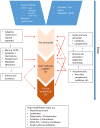Immunopathogenesis of Rheumatoid Arthritis
- PMID: 28228278
- PMCID: PMC5385708
- DOI: 10.1016/j.immuni.2017.02.006
Immunopathogenesis of Rheumatoid Arthritis
Abstract
Rheumatoid arthritis (RA) is the most common inflammatory arthropathy. The majority of evidence, derived from genetics, tissue analyses, models, and clinical studies, points to an immune-mediated etiology associated with stromal tissue dysregulation that together propogate chronic inflammation and articular destruction. A pre-RA phase lasting months to years may be characterized by the presence of circulating autoantibodies, increasing concentration and range of inflammatory cytokines and chemokines, and altered metabolism. Clinical disease onset comprises synovitis and systemic comorbidities affecting the vasculature, metabolism, and bone. Targeted immune therapeutics and aggressive treatment strategies have substantially improved clinical outcomes and informed pathogenetic understanding, but no cure as yet exists. Herein we review recent data that support intriguing models of disease pathogenesis. They allude to the possibility of restoration of immunologic homeostasis and thus a state of tolerance associated with drug-free remission. This target represents a bold vision for the future of RA therapeutics.
Copyright © 2017 Elsevier Inc. All rights reserved.
Figures



References
Publication types
MeSH terms
Grants and funding
LinkOut - more resources
Full Text Sources
Other Literature Sources
Medical

